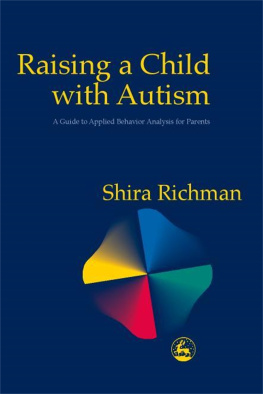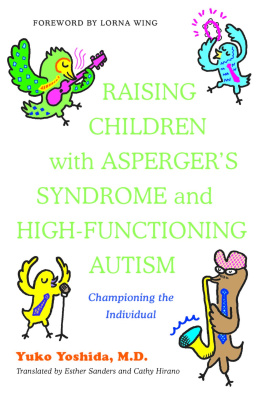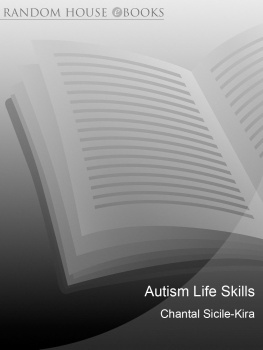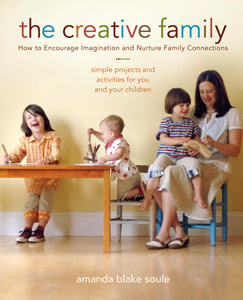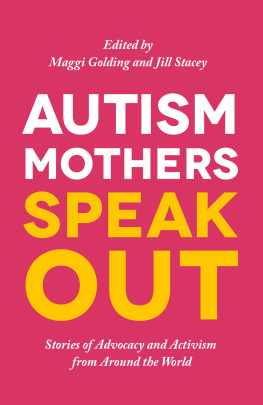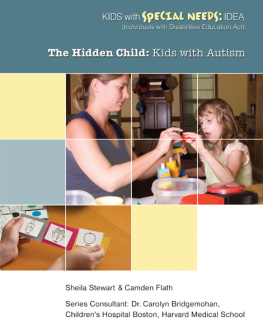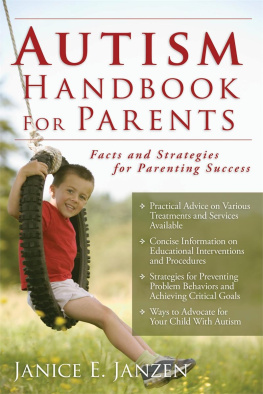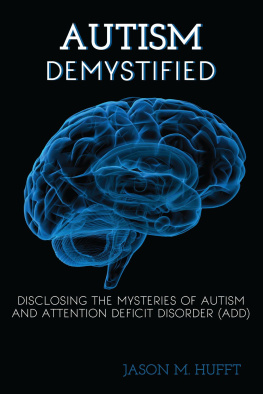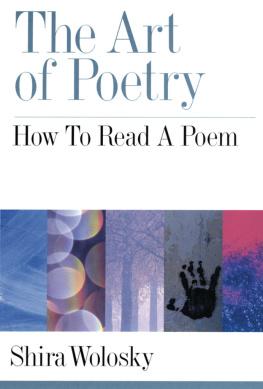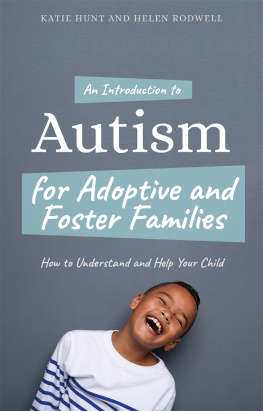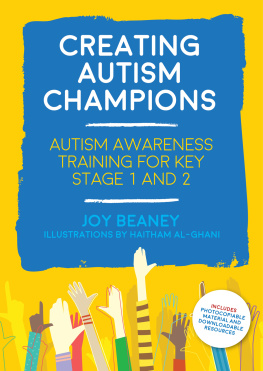Richman Shira - Raising a Child with Autism
Here you can read online Richman Shira - Raising a Child with Autism full text of the book (entire story) in english for free. Download pdf and epub, get meaning, cover and reviews about this ebook. year: 2014, publisher: Jessica Kingsley Publishers, genre: Children. Description of the work, (preface) as well as reviews are available. Best literature library LitArk.com created for fans of good reading and offers a wide selection of genres:
Romance novel
Science fiction
Adventure
Detective
Science
History
Home and family
Prose
Art
Politics
Computer
Non-fiction
Religion
Business
Children
Humor
Choose a favorite category and find really read worthwhile books. Enjoy immersion in the world of imagination, feel the emotions of the characters or learn something new for yourself, make an fascinating discovery.
- Book:Raising a Child with Autism
- Author:
- Publisher:Jessica Kingsley Publishers
- Genre:
- Year:2014
- Rating:4 / 5
- Favourites:Add to favourites
- Your mark:
- 80
- 1
- 2
- 3
- 4
- 5
Raising a Child with Autism: summary, description and annotation
We offer to read an annotation, description, summary or preface (depends on what the author of the book "Raising a Child with Autism" wrote himself). If you haven't found the necessary information about the book — write in the comments, we will try to find it.
Raising a Child with Autism — read online for free the complete book (whole text) full work
Below is the text of the book, divided by pages. System saving the place of the last page read, allows you to conveniently read the book "Raising a Child with Autism" online for free, without having to search again every time where you left off. Put a bookmark, and you can go to the page where you finished reading at any time.
Font size:
Interval:
Bookmark:

Raising a Child with Autism
by the same author
Encouraging Appropriate Behavior for Children on the Autism Spectrum
Frequently Asked Questions
ISBN 978 1 84310 825 2
eISBN 978 1 84642 085 6
of related interest
The Parents Guide to In-Home ABA Programs
Frequently Asked Questions about Applied Behavior Analysis for your Child with Autism
Elle Olivia Johnson
ISBN 978 1 84905 918 3
eISBN 978 0 85700 725 4
A Step-by-Step ABA Curriculum for Young Learners
with Autism Spectrum Disorders (Age 3-10)
Lindsay Hilsen MEd, BCBA
ISBN 978 1 84905 928 2
eISBN 978 0 85700 775 9
The Verbal Behavior Approach
How to Teach Children with Autism and Related Disorders
Mary Lynch Barbera With Tracy Rasmussen
Foreword by Mark L. Sundberg, Ph.D., BCBA
ISBN 978 1 84310 852 8
eISBN 978 184642 653 7
I am Special
A Workbook to Help Children, Teens and Adults with Autism Spectrum Disorders to Understand Their Diagnosis, Gain Confidence and Thrive
2nd edition
Peter Vermeulen
ISBN 978 1 84905 266 5
eISBN 9780857005458
Asperkids
An Insiders Guide to Loving, Understanding and Teaching Children with Asperger Syndrome
Jennifer Cook OToole
Foreword by Liane Holliday Willey
ISBN 978 1 84905 902 2
eISBN 978 0 85700 647 9
Parenting Across the Autism Spectrum
Unexpected Lessons We Have Learned
Maureen F. Morrell and Ann Palmer
ISBN 978 1 84310 807 8
eISBN 978 1 84642 506 6
Raisinga Child with Autism
A Guide To Applied Behavior
Analysis For Parents
Shira Richman

Jessica Kingsley Publishers
London and Philadelphia
First published in the United Kingdom in 2001
by Jessica Kingsley Publishers
73 Collier Street
London N1 9BE, UK
and
400 Market Street, Suite 400
Philadelphia, PA 19106, USA
www.jkp.com
Copyright 2001 Shira Richman
The right of Shira Richman to be identified as author of this work has been asserted by her in accordance with the Copyright, Designs and Patents Act 1988.
All rights reserved. No part of this publication may be reproduced in any material form (including photocopying or storing it in any medium by electronic means and whether or not transiently or incidentally to some other use of this publication) without the written permission of the copyright owner except in accordance with the provisions of the Copyright, Designs and Patents Act 1988 or under the terms of a licence issued by the Copyright Licensing Agency Ltd, Saffron House, 6-10 Kirby Street, London EC1N 8TS. Applications for the copyright owners written permission to reproduce any part of this publication should be addressed to the publisher.
Warning: The doing of an unauthorised act in relation to a copyright work may result in both a civil claim for damages and criminal prosecution.
Library of Congress Cataloging in Publication Data
Richman, Shira. 1972
Raising a child with autism: a guide to applied behavior for parents / Shira Richman.
p. cm.
Includes bibliographical references.
ISBN 1-85302-910-6 (alk. paper)
1. Autistic children. 2. Autistic children--Behavior modification. 3. Parents of autistic children. 4. Autism. I. Title
RJ506.A9 R535 2000
618.928982--dc21
00-047818
British Library Cataloguing in Publication Data
A CIP catalogue record for this book is available from the British Library
ISBN 978 1 85302 910 3
eISBN 978 1 84642 698 8
Contents
In loving memory of Leon Lantz, my grandfather and my
inspiration as a writer and as an individual.
To Evan, my husband, for always believing in me and
for his unconditional love and support, without which I could
not have written this book.
With special thanks to our parents, Esther
and Mervin Verbit and Miriam and Paul Richman, for raising
us with much patience and love.
Thank you to all the children with whom I have worked,
to their wonderful parents, and to the professionals who
taught me much along the way.
CHAPTER 1
What is Autism?
Signs and symptoms of autism
Autism is a pervasive developmental disorder that affects approximately ten to fifteen out of every ten thousand children. Its onset usually occurs prior to thirty months of age, but only becomes easily detectable when the childs failure to develop communicative language becomes apparent.
Childhood disintegrative disorder shares the same symptoms as autism, but in this condition normal development is exhibited for the first two years of life, followed by a significant loss of previously acquired skill. Autism occurs in boys about three times as often as it occurs in girls, and its specific etiology is not yet known.
The diagnostic standard used to identify autism is called the Diagnostic and Statistical Manual of Mental Disorders of the American Psychiatric Association, fourth edition, or the DSM-IV, published in 1994. It includes twelve diagnostic criteria grouped into three categories: social interaction, communication, and activities and interests. Individuals affected with autism will not necessarily have all of the signs and symptoms associated with the disorder. Although they may exhibit similar symptoms, no two children with autism are alike. In order to be diagnosed with autism, a child must exhibit two criteria from the first category, two criteria from the second category, and one from the third. Here is a closer look at each diagnostic category within the DSM-IV:
Social interaction
Children with autism do not have proper use and understanding of nonverbal behaviors, nor do they exhibit age-appropriate social interaction. A child with autism may:
exhibit little if any eye contact
be unable to read facial expressions or respond to social cues and gestures, such as waving and pointing
fail to interact and to develop appropriate peer relationships
prefer isolation and appear uninterested in other people
use people as tools by guiding their hands in order to retrieve an object that the child desires
exhibit minimal or no initiation and play skills.
In infancy a child with autism may not exhibit an anticipatory response to being picked up and may not like to be held. He may not play peek-a-boo or visually follow the coming and going of his caregiver. As a toddler, the child may not exhibit normal stranger anxiety, and may show either little or extreme attachment to people.
Communication
Children with autism show qualitative disturbances in speech as well as quantitative ones. In other words, the speech of children with autism is not merely delayed, but is not evenly developed. Inappropriate use of language may include:
echolalia (rote repetition of words and/or phrases)
a monotonous tone lacking pitch or intonation
lack of social imitative play and spontaneity and variation in language use
pronoun reversals
a discrepancy between receptive and expressive language with no concept of abstractions such as danger.
Approximately forty percent of children with autism do not develop language at all, nor do they try to compensate through the use of alternative methods of communication such as gestures or mime. Those who do develop speech do not use their speech skills to converse with others appropriately.
Next pageFont size:
Interval:
Bookmark:
Similar books «Raising a Child with Autism»
Look at similar books to Raising a Child with Autism. We have selected literature similar in name and meaning in the hope of providing readers with more options to find new, interesting, not yet read works.
Discussion, reviews of the book Raising a Child with Autism and just readers' own opinions. Leave your comments, write what you think about the work, its meaning or the main characters. Specify what exactly you liked and what you didn't like, and why you think so.

